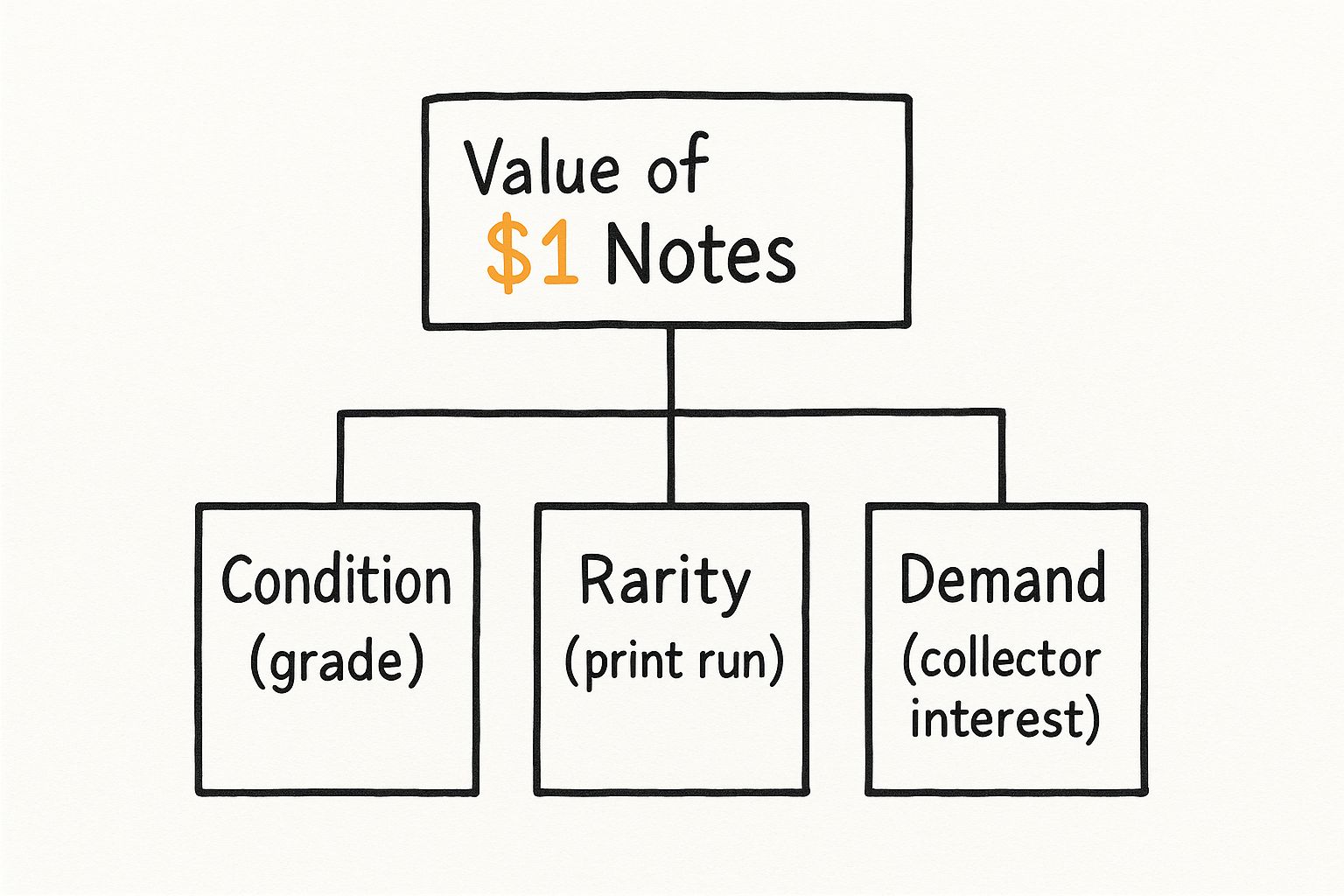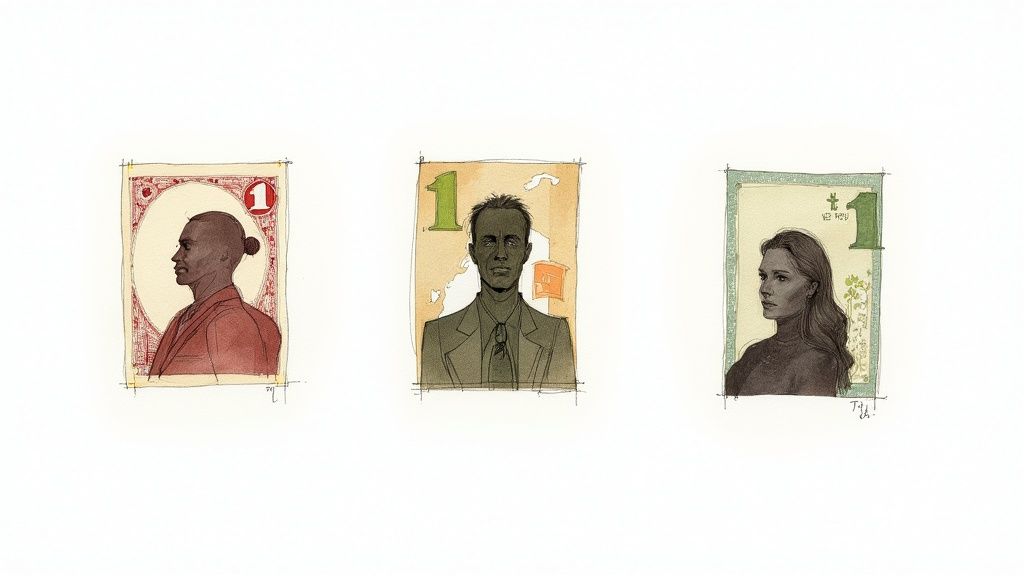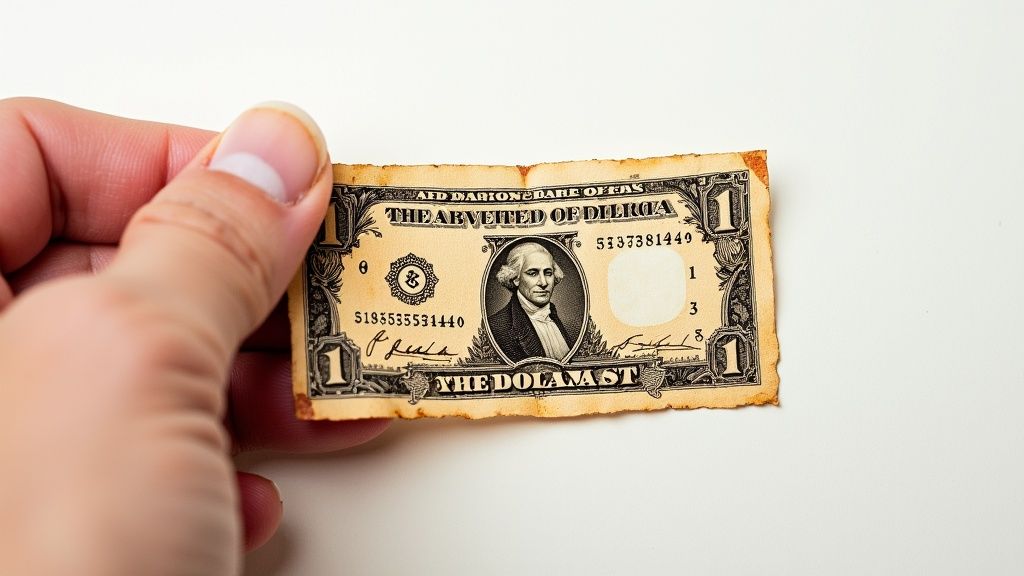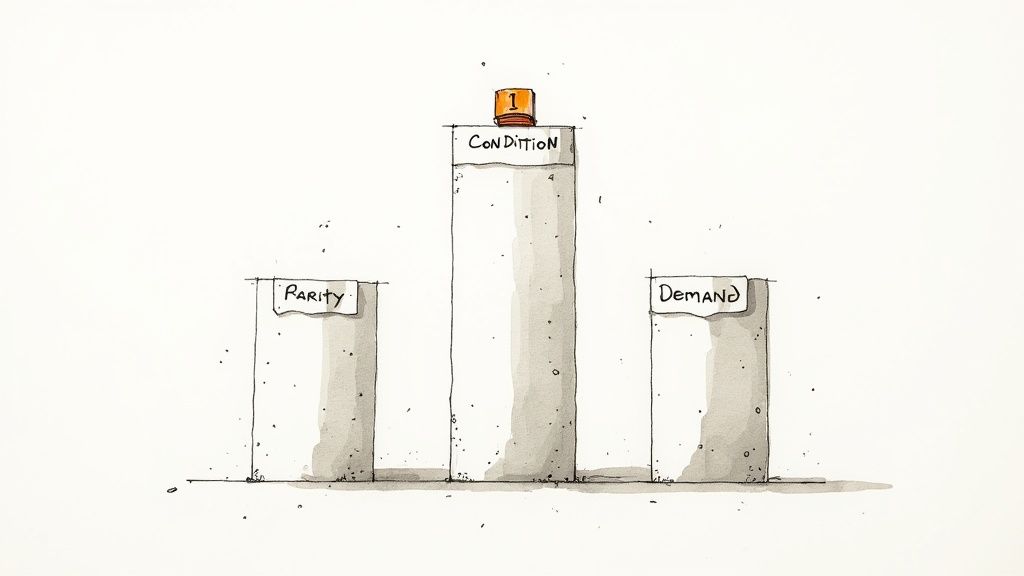The real value of £1 notes isn't what's printed on them; it's whether they're collectible. While a common, crumpled old note from your pocket change might only be worth a couple of quid, a rare and pristine example could easily fetch hundreds—or even thousands—at auction.
The trick is knowing what turns a simple bit of currency into a sought-after piece of history.
What Determines the Value of a £1 Note?
Think of an old £1 note less as money and more as a tiny paper time capsule. Its value is all tied up in the story it tells, how many others like it are out there, and how well it has survived its journey.
Four main things really drive a banknote's collectible worth: its rarity, its physical condition, its historical significance, and any unique quirks like a special serial number. These factors all work together. A note from a tiny print run (making it very rare) that's torn and tattered will lose a huge amount of its value. On the flip side, a common note that looks like it just came off the printing press will always be worth more than its folded, faded siblings.
The Core Pillars of Banknote Valuation
When collectors and sellers look at a £1 note, they're really asking a few key questions to gauge its value:
- Rarity: Just how many of these were ever printed? The fewer notes that exist from a particular series or with a specific signature, the more desirable they become. Early print runs, which you can spot by their low serial numbers (like 'A01'), are especially prized by collectors.
- Condition (Grade): This is arguably the most critical factor of all. A crisp, uncirculated note with no folds, stains, or tears is the absolute gold standard and will always command the highest prices. Honestly, even a single fold can slash a note's value by more than half.
- Unique Features: Little oddities can make a big difference. Printing errors, unusual serial numbers (like '123456' or a 'solid' like '888888'), and special commemorative issues can launch a note’s worth far beyond its standard value.
This gives you a clear idea of how a note's value is built—it's a delicate balance between its condition, rarity, and the simple fact of how many people want it.

Quick Guide to a £1 Note's Value
To make things a bit simpler, here’s a quick rundown of the key things to look for. Think of this as your starting checklist for figuring out if that old note is a treasure or just a keepsake.
| Factor | What It Means for Collectors | Impact on Value |
|---|---|---|
| Rarity | Low print runs, early serial numbers (e.g., A01), or specific signatures. | The rarer the note, the higher the demand and price. |
| Condition | Graded from poor to Uncirculated. A single fold can drop the grade significantly. | Pristine, crisp notes are worth massively more than worn ones. |
| Errors | Mistakes in printing, like misaligned text, incorrect colours, or cutting errors. | Unique errors are highly sought-after and can create huge value. |
| Serial Numbers | 'Fancy' numbers like solids (111111), ladders (123456), or low numbers. | These are collector catnip and dramatically increase a note's worth. |
Ultimately, these are the core components that dictate whether a note is a common piece of history or a valuable collectible.
If you're interested in how value is assessed more broadly across different types of collectibles, you can find some fascinating insights in this expert guide on the principles of pawn shop valuation.
The Story of the British £1 Note

To really get a feel for a £1 note's value, you have to look past its condition or serial number and dive into its history. Think of each note as a little time capsule; its story is what makes it scarce and desirable for collectors today. The British £1 note wasn't always a common sight in our wallets—its history is a fascinating tale of emergency, necessity, and constant evolution.
The note first popped up sporadically during national crises. At the start of World War I in 1914, the government issued Treasury £1 notes to stand in for gold sovereigns, which people were understandably hoarding. It wasn't until 1928, though, that the Bank of England rolled out its first fully machine-printed, two-sided £1 note, a huge leap forward in modernising our currency.
This move from an emergency fix to a standard banknote created distinct production eras, each with its own rarities that collectors now hunt for.
From Wartime Necessity to Everyday Staple
During the Second World War, the design of the £1 note was simplified to speed up production. This emergency issue, printed between 1940 and 1948, featured blue and pink colours and a metal security thread. Notes from this period are incredibly collectible because they represent a specific, pivotal moment in history and tell a story of British resilience.
After the war, the designs changed again. The real game-changer came in 1960 with the 'Series C' portrait notes, which featured a young Queen Elizabeth II. It was a landmark moment—the very first time a monarch's portrait had appeared on a Bank of England £1 note, setting a new standard for currency design.
The signature of the Chief Cashier on a banknote is more than just an autograph; it’s a timestamp. Each new signature marks a new print series, creating distinct and limited production runs that are essential for collectors to identify.
The Final Chapter and Its Legacy
The last design, 'Series D', arrived in 1978 and featured the brilliant Sir Isaac Newton on the reverse. These green notes became the familiar face of the pound for an entire generation before they were eventually phased out.
Why the change? It came down to pure practicality. The average £1 note only lasted about nine months in circulation. The new £1 coin, introduced in 1983, was built to last for over 40 years. So, on 11 March 1988, the £1 note officially ceased to be legal tender, bringing its long and storied history to a close.
It’s this withdrawal that makes these notes so collectible today. Understanding this timeline—from wartime substitute to everyday workhorse and finally to a historical relic—is the key to seeing why some notes are far rarer, and more valuable, than others. To get a broader perspective, you can also explore our article on the evolution of money.
How to Identify Valuable Banknotes

Alright, you now understand the history and what makes a note tick in terms of value. It's time to put that theory into practice. Spotting a potentially valuable £1 note is a bit like being a detective; you need to know exactly what clues to look for, and the biggest ones are often hidden in plain sight.
The process kicks off with a quick, systematic check of a few key features. With a little practice, you'll be able to scan any note and instantly pick out the tell-tale signs of a rare find. Think of it as developing a collector's instinct—training your eye to see far beyond the face value.
Decoding the Serial Number
Of everything on a note, the serial number is probably the single most important element in figuring out its rarity. It’s a unique identifier that tells a story about when and where that specific note was printed. For collectors, certain combinations are a whole lot more desirable than others.
A low serial number is a fantastic place to start. Any note with a prefix like 'A01' comes from the very first print run of that series, making them exceptionally scarce and sought-after. Finding one of these is like discovering a first-edition book on a dusty shelf.
Beyond just low numbers, collectors are always on the hunt for "fancy" serial numbers. These are simply sequences that create an interesting or appealing pattern. Here are some of the most popular types to keep an eye out for:
- Solids: All the digits are the same (e.g., 444444).
- Ladders: The digits run in perfect sequence, either up or down (e.g., 123456 or 654321).
- Radars (or Palindromes): The number is a mirror image, reading the same forwards and backwards (e.g., 123321).
- Repeaters: The first few digits repeat to make up the full number (e.g., 123123).
The Significance of the Signature
Every Bank of England note carries the signature of the Chief Cashier who was in office when it was printed. This signature is much more than just an autograph; it’s a timestamp that pinpoints the note’s production era with precision.
When a new Chief Cashier is appointed, a new signature appears on the notes, creating distinct and limited production runs. Some cashiers had very short tenures, which means far fewer notes bear their signature. These "short run" signatures are significantly rarer and can dramatically increase the value of 1 notes, even if the design itself is quite common.
For a seasoned collector, the Chief Cashier's signature is a vital clue. It’s often the very first thing they check, as it can instantly separate a common note from a rare variant within the same series.
Spotting Valuable Printing Errors
While banks and printers aim for perfection, mistakes inevitably happen during the production process. For a collector, these errors aren't flaws—they are highly prized rarities. A unique mistake makes a note one-of-a-kind, and its value can skyrocket as a result.
Look for anything that just seems a bit off or unusual. Some of the more common types of valuable errors include:
- Mismatched Serial Numbers: The two serial numbers printed on the note don't match.
- Colour Errors: A note might be missing a colour entirely, or have colours that are dramatically different from the standard issue.
- Cutting Errors: The note may have been cut incorrectly, showing a slice of the adjacent note from the printing sheet.
- Fold-Over Errors: Part of the note was folded during printing, which leaves a blank area and a bit of the design printed on the back.
Identifying these features is a crucial skill for any collector. Of course, it's just as important to be able to tell a genuine note from a forgery. To give you a hand with that, you can learn more about the 7 essential banknote security features to spot counterfeits in our detailed guide.
Understanding Banknote Grading and Condition

When you step into the world of collecting, you quickly learn one golden rule: condition is everything. A crisp, untouched £1 note can be worth hundreds of times more than an identical one that’s been folded, stained, and passed through countless hands. In many cases, this single factor has a far bigger impact on the value of 1 notes than rarity or even age.
Think of it like collecting classic cars. An 'Uncirculated' (UNC) note is the showroom model – perfect, untouched, and never driven. It boasts sharp corners, vibrant colours, and absolutely no signs of handling. On the other hand, a 'Fine' note is more like a reliable old daily driver. It’s done its job, shows visible wear like multiple folds and softness, but it's still complete and respectable.
It's this massive difference in condition that makes professional grading so vital for figuring out a note's true market value.
The Official Banknote Grading Scale
Grading gives collectors a shared, universal language to talk about a note's physical state. The full scale is incredibly detailed, but most of the notes you'll come across will fit into one of a few key categories. Getting your head around these grades is the first step to quickly assessing what you have.
- Uncirculated (UNC): The cream of the crop. A flawless note with zero signs of wear, folds, or handling. This is the highest grade possible and naturally commands the highest prices.
- About Uncirculated (AU): Looks perfect at first glance, but a closer look might reveal a single, light fold (often down the centre) or very minor signs of being handled.
- Extremely Fine (EF): A lovely, crisp note that still has most of its original stiffness. It might have a few light folds but shows very little evidence of circulation.
- Very Fine (VF): Here, you can see the note has been in circulation. It will have several folds and feel a bit softer, but the design is still clear and it remains an attractive piece.
- Fine (F): This note is noticeably worn and soft from being used quite a bit. It’ll have multiple folds and creases but is still complete with no major damage.
Below these are grades like 'Very Good' (VG), 'Good' (G), and 'Poor' (P), which describe notes with much more significant wear, damage, tears, or stains.
Common Flaws That Destroy Value
Even the smallest imperfections can send a note's grade—and its value—plummeting. When you're examining a note, you need to become a detective, hunting for these common value-killing flaws.
A single, hard centre fold can instantly slash the value of an otherwise perfect Uncirculated note by 50% or more. This is precisely why proper handling and storage are non-negotiable for serious collectors.
Keep a sharp eye out for these key defects:
- Folds and Creases: The number one enemy. Hard folds that actually break the paper's fibres are far more damaging than gentle bends.
- Tears and Pinholes: Any break in the paper, no matter how tiny, is a major flaw in a grader's eyes.
- Stains and Writing: Ink marks from a teller's pen, dirt, or any discolouration are serious defects that are almost impossible to fix.
This obsession with preservation is exactly why the £1 note was phased out in the first place. The average paper note had a lifespan of just 9 months before it became too tatty for circulation. The £1 coin that replaced it, by contrast, could last for up to 40 years, offering enormous long-term savings. You can learn more about this switch by exploring a complete history of the British pound coin.
Putting a Price on Your £1 Notes
So, how do all these little details—the condition, the rarity, the signature—actually come together to determine what a banknote is worth? This is where the rubber meets the road, moving from interesting facts to a tangible market price. Figuring out what your banknote might fetch really comes down to seeing what similar notes have sold for recently.
For collectors, this means turning to a few trusted sources to get a realistic picture of a note's value. The go-to resources are always auction house results, dealer price lists, and specialised numismatic catalogues. These give you a transparent record of the current market, helping you tell the difference between a common find and a genuinely rare treasure.
Case Studies in Valuation
Let's walk through a couple of real-world examples to see just how much specific features can move the needle on a note's final value.
Imagine you have two £1 notes from the final 'Series D' issue, both featuring Sir Isaac Newton.
- Note A: A fairly standard note with a high serial number, signed by D.H.F. Somerset. It's been folded several times and feels soft and worn. In this state, its value is pretty minimal—probably just a few pounds over face value, more of a historical curiosity than anything else.
- Note B: An identical note, also signed by Somerset, but this one is in crisp, Uncirculated (UNC) condition. Crucially, it has the highly sought-after 'A01' prefix, marking it as one of the very first off the press. This note could easily be worth £50-£100, maybe even more, purely because of its perfect condition and rare serial number.
This simple comparison shows you just how dramatically condition and rarity can transform the value of 1 notes.
A key thing for any collector to remember is that the market is always moving. Prices are driven by supply and demand, so a rare note that suddenly becomes popular can see its value shoot up. Always check the latest sales data for an accurate valuation.
Finding Reliable Pricing Information
To get a proper feel for what your collection might be worth, you need to know where to look. Here are the main places that professionals and seasoned collectors turn to:
- Dealer Websites: Reputable banknote dealers often list their stock with fixed prices. This is a brilliant way to see the current retail value for notes in various grades.
- Auction Results: Major auction houses publish the prices their lots sold for. This gives you direct insight into what collectors are actually willing to pay for specific notes right now.
- Specialised Catalogues: Publications like the English Paper Money guide are indispensable. They offer comprehensive listings and estimated values for just about every British banknote ever issued.
In recent years, old £1 notes have sometimes sold at auction for hundreds, or even thousands, of pounds. This usually happens with specimens from rare issues or those in absolutely pristine condition, proving their ongoing cultural value long after they stopped being legal tender. You can find out more about the history of pound sterling banknotes on Wikipedia.
The image below shows several series of Bank of England notes, giving a great visual of how the designs changed over time.
Each series shown here represents a distinct era in British history, with its own unique rarities and valuations. These are driven by factors like the Chief Cashier's signature and the size of the print run. For a deeper dive into the principles of valuation, have a look at our detailed guide on the value of old paper money.
So, What Happened to the £1 Note?
The disappearance of the trusty £1 note wasn't an overnight decision. It was a carefully calculated move that spelled the end of an era for British money, and the reason boils down to a classic battle: durability versus cost.
Think about the paper banknote in your wallet. It's not meant to last forever. The average £1 note, in particular, had a surprisingly short life, lasting just nine months before it became too tatty, torn, or crumpled to be of any use. This created a constant, expensive cycle for the Treasury: print, distribute, destroy, repeat.
The Inevitable Switch to Coins
Now, compare that to the chunky £1 coin introduced back in 1983. This thing was built like a tank. A single coin could easily survive the hustle and bustle of daily life for 40 years or more.
Suddenly, the maths became very simple. While minting a coin cost more upfront, the long-term savings were massive. That practical, economic argument pretty much sealed the paper note's fate.
This shift wasn't just about money, though. It also mirrored how society was changing. With new payment technologies emerging, the need for a low-value, high-turnover paper note was fading fast. This deliberate phasing out is a huge part of why these old notes have become so historically interesting, and it directly feeds into the collectible value of £1 notes today.
By the end of 2016, the total value of all currency circulating in the UK was around £80.4 billion. The humble £1 note had been gone for nearly three decades by then, a stark reminder of how completely the coin had taken over. If you're interested in the numbers, you can dive into more currency data from the Bank of England via the FRED database.
Your Top Questions About £1 Note Values Answered
Dipping your toes into the world of banknote collecting is exciting, but it naturally comes with a few questions. We often hear from collectors, both new and seasoned, about figuring out the value of their £1 notes. Let's clear up some of the most common queries.
Are All Old £1 Notes Valuable?
Not always. It's a common misconception that age alone equals value. While an old note is certainly interesting, the real value comes from a combination of rarity, condition, and any unique features.
A heavily folded and creased note from the 1980s might only be worth a pound or two over its face value. But find an uncirculated note from an early print run, or one with a special serial number, and you could be looking at something far more valuable.
How Can I Get an Accurate Valuation?
For a really precise value, your best bet is to chat with a professional numismatic dealer or get your hands on a current banknote price guide. If you just want a good estimate, have a look at what similar notes have recently sold for on auction sites.
Remember to compare apples with apples. The condition, or grade, of your note is often the single biggest factor in its final price. A crisp, clean note will always fetch more than a tired, well-worn one.
When you're doing your comparisons, pay close attention to the grade, the chief cashier’s signature, and the serial number prefix. These details make all the difference.
When Should I Get My Note Graded?
Getting a note professionally graded is really for the big hitters. If you believe you have a particularly high-value note, it’s a smart move.
Think about grading if your note is:
- In pristine, uncirculated condition.
- Has a very rare or desirable serial number.
- Is from a particularly early or significant series.
Grading authenticates the note and can seriously boost its market value. For more common notes in circulated condition, the grading fee would probably be more than the note itself is worth.
At Cavalier Coins Ltd, we live and breathe numismatics and love helping collectors discover that next special piece. Why not take a look through our hand-picked selection of fascinating banknotes from all over the world?

